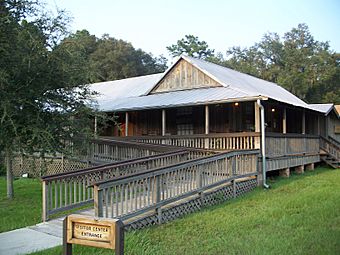Dudley Farm Historic State Park facts for kids
Quick facts for kids |
|
|
Dudley Farm
|
|

Dudley Farm visitor center
|
|
| Location | Alachua County, Florida, U.S. |
|---|---|
| Nearest city | Newberry |
| Area | 325 acres (1.32 km2) (NRHP-listed area) 240 acres (97 ha) (NHL-designated area) |
| Built | October 4, 2002 |
| NRHP reference No. | 100006234 |
| Designated NHLD | January 13, 2021 |
Dudley Farm Historic State Park (Florida), also known as Dudley Farm, is a U.S. historic district and museum park located in Newberry, Florida. It was added to the U.S. National Register of Historic Places on October 4, 2002, and was designated a National Historic Landmark in January, 2021. The address is 18730 West Newberry Road (Florida State Road 26). The farm is a particularly fine and well-preserved example of a mid-19th to mid-20th century farm.
Description
The park encompasses approximately 325.6 acres (1.318 km2), and contains 21 historic buildings and 13 structures, including the family farmhouse, an 1880s kitchen outbuilding, a general store and post office, and a cane syrup complex, all with original furnishings.
The southern portion of the park contains visitor parking, a visitor center, a gift shop, old barns and farming equipment, and a 0.3 mile nature walk through a Florida hammock. The visitor center was originally a house built in Newberry in 1918. The gift shop is an exact duplicate of a commissary once found on a 19th century Florida turpentine plantation. This section of the park is on property not owned by the Dudley family.
The Dudley farm is accessed by a trail near the visitor center. It maintains a registered Cracker cattle herd, and at least one Florida Cracker horse. There are also chickens and turkeys on the farm. These are specimens of poultry breeds common on late 19th and early 20th century U.S. farms. During part of its existence, the farm was a large, local egg producer. The site is a working farm, showing agricultural development in Florida from the late 1850s through the mid-1940s. After that period, the farm was used solely for subsistence farming by a few third-generation family members. In 1996, Myrtle Dudley, the youngest and last living member of the third generation, died, leaving the site to the Florida Park Service.



